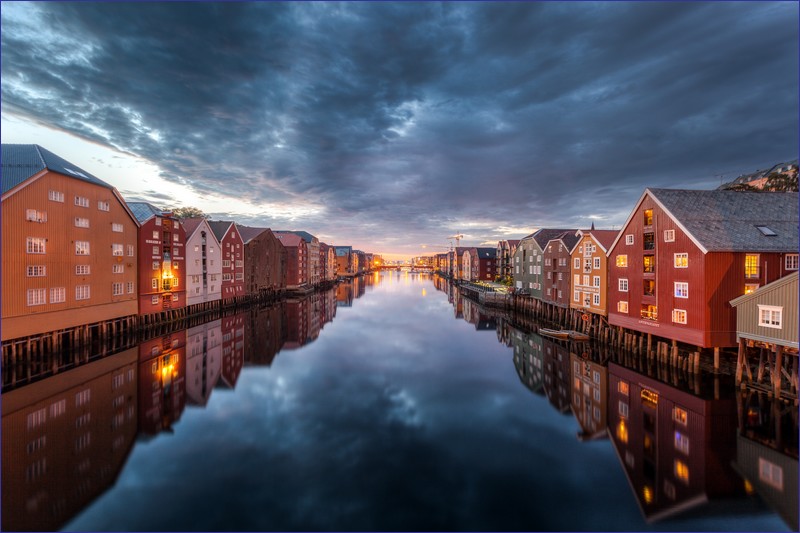Trondheim is the northernmost large city in Norway. It was founded in 997 by Olaf Tryggvason as Nidaros and served as the capital of Viking Norway until 1217. During the Middle Ages, it was the site of Norwegian royal coronations. The name Nidaros was used until the Danish conquest of Norway, after which it was changed to Trondhjem.
In 1651, a great fire destroyed 90% of the city. Trondheim was rebuilt according to the plans of engineer Johan Caspar von Cicignon (1625–1696) from Luxembourg. A characteristic element of the new city layout was the inclusion of wide avenues, designed to prevent the spread of fires in the future.
Today, Trondheim is the third-largest city in Norway by population (over 200,000 residents), after Oslo and Bergen.
Main Landmarks and Attractions:
Nidaros Cathedral (Nidaros Domkirke) – The most important monument in the city. This northernmost medieval cathedral is also the largest medieval building in Scandinavia. It was built on the site of a wooden chapel that once attracted crowds of pilgrims to the grave of King Olaf II Haraldsson, known as the King of the Vikings. Construction, led by English builders, began in the mid-11th century, and the cathedral was gradually expanded over the centuries. It suffered several fires and was rebuilt multiple times. The largest restoration effort, lasting nearly 100 years, took place after a 19th-century fire. The cathedral impresses even those who are not typically interested in religious monuments. It is the traditional site of Norwegian royal coronations.
Archbishop’s Palace – A former residence of bishops dating back to the 12th century. Located next to the cathedral, it served as the archbishop’s residence until 1537. Afterward, it became the seat of the Danish governor and was later taken over by the military. Part of the palace was destroyed in a fire in 1983. Following the fire, the building underwent extensive renovation. Today, it houses the Archbishop’s Palace Museum, which includes exhibits on the cathedral’s history and archaeological finds from the site. The building also contains the Museum of the Resistance Movement and an Armory that visitors can explore.
Bakklandet – A charming district known for its wooden warehouses along the Nidelva River, narrow streets, and the famous Gamle Bybro (Old Town Bridge), one of Trondheim’s landmarks. The bridge, built in 1861, replaced the original from 1681. The area is lively and popular with tourists, full of cafes and restaurants. One of the most unique attractions here is possibly the only bicycle lift in the world, which helps cyclists reach the hill where the fort is located.
Kristiansten Fortress (Kristiansten festning) – Built in 1681 on a hill overlooking the city center. During World War II, the occupying authorities turned it into a prison where members of the resistance were executed. Today, the fortress serves as a scenic viewpoint, offering panoramic views of the city.
Munkholmen – A small island about 2 kilometers from the city center. In the early Middle Ages, it was a site of executions. In the 11th century, a Benedictine monastery was founded there, which was later converted into a fortress and prison during the Reformation. The most important part of the fortress is the Powder Room, a round chamber with a vaulted ceiling built to contain any explosion and protect the rest of the structure. Initially carved into rock underground, it was abandoned due to water infiltration that made the gunpowder unusable. The former powder room was then turned into a notorious high-security prison. The island can be reached by boat from the Ravnkloa pier.
Ringve Museum of Music History (Ringve Museum) – The only museum of its kind in Norway. It is divided into two sections. The first is the former home of the museum’s founders, who were collectors of musical instruments. This part is visited with a guide. The second section is housed in a modern building opened around the turn of the 21st century and can be explored independently. The permanent exhibit features a rich collection of musical instruments from around the world.
Skansen (Norwegian: Sverresborg Trøndelag Folk Museum) – Located about 30 minutes from the city center, this open-air folk museum is a fascinating site. The museum grounds feature around 60 historic buildings relocated from Trondheim and surrounding areas. The most significant structure is the Haltdalen stave church from the year 1170. Most of the buildings date from the 18th and 19th centuries. A reconstructed Sámi camp is especially popular. In the summer, traditional craft demonstrations and children’s workshops are held. The site also includes a Telecommunications Museum.
Museum of Archaeology and Natural History (Norwegian: Vitenskapsmuseet) – A large museum with diverse exhibitions. The most popular displays include taxidermied animals and a mineral collection from around the world. Noteworthy exhibitions cover the history of Trondheim from its founding to the great fire of 1681, as well as the history of the church in Norway.
Museum of Justice (Norwegian: Justismuseet) – A small museum dedicated to the history of the Norwegian justice system and notable criminal cases. It is housed in two buildings: a former military hospital and an old prison. Highlights include a reconstructed room of Ludvig Wang, who famously escaped from prison; an executioner’s chamber; exhibits on uniforms; a display about 19th-century prostitution; and the office of a former police commissioner.
Art Museum (Norwegian: Trondheim kunstmuseum) – The third-largest art museum in Norway. Its permanent collection showcases the work of renowned painters from the 1800s to the present day.
TV Tower (Norwegian: Tyholttårnet) – Located two kilometers east of Trondheim’s city center, this 124-meter-high TV tower includes the Egon restaurant on two levels. At 74 meters, there is an observation deck offering panoramic views of the city.
Related articles:
Train travel in Norway – a comprehensive guide
